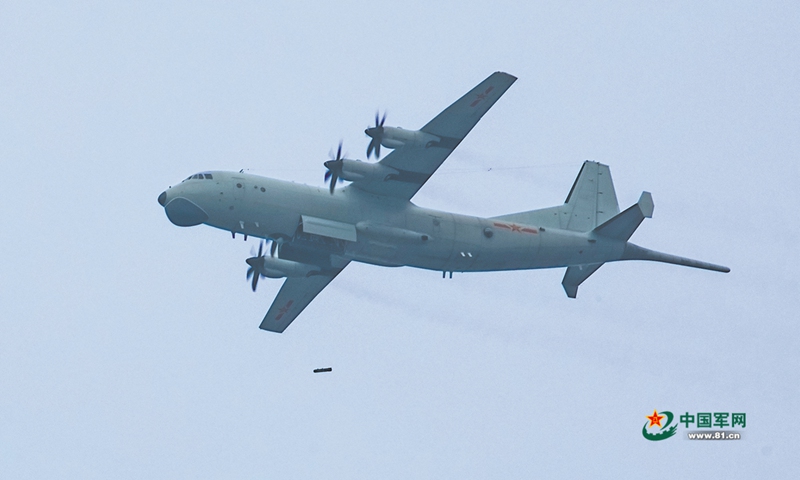PLA anti-submarine warfare aircraft conducts depth charge attack drills, seen as deterrent to Taiwan secessionists
By Liu Xuanzun Source: Global Times Published: 2020/12/6 22:12:10 Last Updated: 2020/12/6 23:36:49

A Y-8 anti-submarine warfare aircraft attached to a division under the People’s Liberation Army Eastern Theater Command Naval Aviation Force drops a depth charge in a training exercise in 2020. Photo: 81.cn
In a rare report shared with media, an anti-submarine warfare aircraft of the Chinese People's Liberation Army (PLA) was shown dropping a new type of depth charge in a recent training exercise, demonstrating its capability to not only detect, but also launch attacks on submarines, analysts said on Sunday.
The report came only a week after the island of Taiwan announced the start of construction of its new submarine fleet, and could be seen as a deterrent to Taiwan secessionists' attempts to use force to resist reunification, they said.
A division under the PLA Eastern Theater Command Naval Aviation Force recently held a live-fire anti-submarine training exercise, the PLA Daily reported on Thursday.
During the exercises, a Y-8 anti-submarine warfare aircraft deployed a new type of air-droppable, self-guided depth charge from its belly, and accurately hit its intended target, according to the report and a photo attached to it.
Multiple depth charges were used in the real scenario exercises, which boosted the aircraft's anti-submarine warfare capability, the report said.
It is rare for an official report to showcase a depth charge deployment from an anti-submarine warfare aircraft, Ordnance Industry Science Technology, a defense magazine based in Xi'an, Northwest China's Shaanxi Province, said in an article published on Friday.
The Y-8 anti-submarine warfare aircraft, which is also sometimes referred to as the Y-9, KQ-200 or GX-6 anti-submarine warfare aircraft, has been commissioned to the PLA Navy in large batches in recent years, and is of major significance in enhancing the service's anti-submarine warfare capability, the magazine said.
In addition to advanced submarine detection equipment, the aircraft is designed with large weapons bays that can carry torpedoes, mines and depth charges. This means that upon detecting a hostile submarine, the aircraft can proceed to directly drop a weapon of choice to attack it without requesting other warships or submarines to do so, the article said.
Compared with a torpedo, a depth charge is less powerful, but is much smaller and cheaper, the magazine said, noting that the use of this new type of depth charge, together with air-droppable torpedoes, will greatly increase the Y-8 anti-submarine warfare aircraft's combat efficiency and flexibility, and be highly effective in potential future battles against the military on the island of Taiwan.
According to the defense authority on the island of Taiwan, the Y-8 anti-submarine warfare aircraft has been one of the most frequent visitors near the Taiwan island since mid-September, when the PLA carried out a large-scale maritime and aerial exercise near the Taiwan Straits.
In late November, Taiwan island held a high-profile ceremony marking the start of construction for its new submarine fleet, which will purportedly be able to counter the Chinese mainland.
Displaying the Y-8 anti-submarine warfare aircraft's exercises with its new weapon could be seen as a warning to Taiwan secessionists, as it demonstrates the PLA's capability in dealing with underwater threats in the Taiwan Straits, a Chinese mainland military expert who asked not to be named told the Global Times on Sunday.
Any attempts to use force to resist reunification will be futile, the expert said.
Wei Dongxu, a Beijing-based military expert, told the Global Times that the mainland can monitor submarine movements in the Taiwan Straits, and Taiwan submarines will not be able to have a very big impact.
Posted in: MILITARY